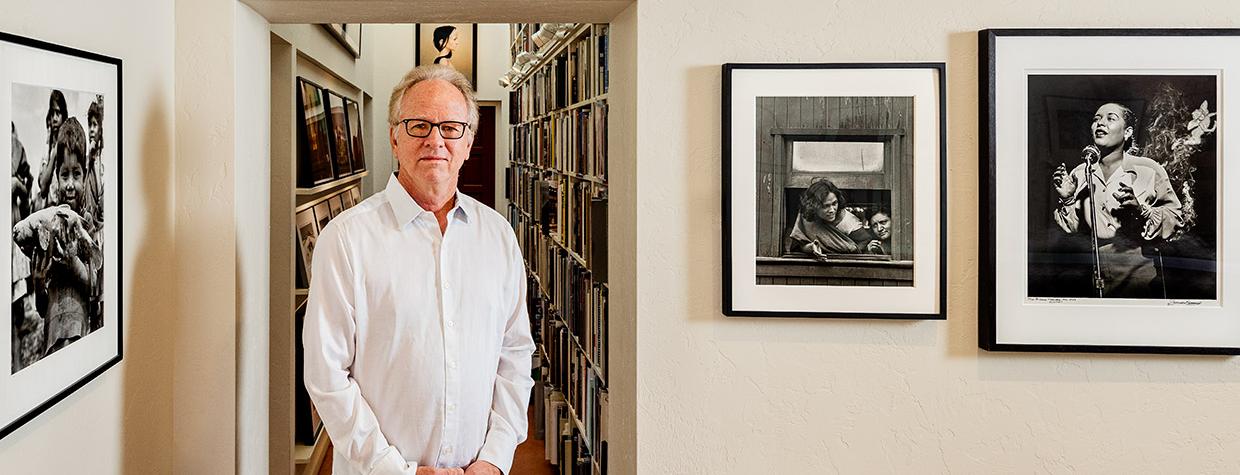JK: Were you interested in art from a young age?
TE: Not really. I didn’t grow up in a family that paid a lot of attention to art. After I graduated from high school in 1969, I was drafted into the U.S. Army, and when I was stationed out in Kansas, there was a darkroom there. I bought a Yashica-Mat camera at the PX and became familiar with photography that way. After I left the Army, I went to Southern Illinois University and double-majored in photography and cinematography.
JK: From there, you headed to San Francisco. What drew you to the Bay Area?
TE: I spent part of my Army years in the Monterey area, and we’d hitchhike up to San Francisco if we had spare time. I told myself I was going to live there someday. Once I moved there, I worked as a cinematographer for several years, shooting training and industrial films and some documentaries. It was a hard lifestyle: At times, I’d work every day for six months, then do nothing at all for three months. Eventually, I decided on a whim to move to Tucson, a place I’d visited between film projects.
JK: Where did you get the idea to open your own gallery?
TE: When I was getting my degrees, I figured I was going to be an artist. Then I found out I wasn’t that good. But I always wanted to figure out how to make a living doing something I really liked. When I came to Tucson, the Center for Creative Photography had opened recently, and I realized something big was happening there. I also realized that there was no one in Arizona selling photographs, and I decided to just give it a shot and see what happened. People always ask me what my business plan was, and I still don’t know what that means. I just did it by the seat of my pants. One day, I was downtown and saw a “For Rent” sign across the street. I called the owner, and the rent was $235 a month. I opened my first gallery there in 1981.
JK: Did you have any idea what went into running a gallery?
TE: I knew enough from living in the Bay Area that I was familiar with some well-known photographers, and I also had spent a lot of time around galleries. I knew enough about hanging a show, framing and writing press releases. Initially, it was just me, and the rent wasn’t much, so the stakes were very low. I knew a little about a lot of things, but I didn’t know anything about running a business. As time went on, I had to figure it all out.
JK: What was the first show?
TE: The first was a Harold Jones show. He was the first director of the CCP, so it was a good show to have. Harold knew everybody, so I met everybody quickly when they came to see his show. But the second show was a 20-year Danny Lyon retrospective, and that changed everything. I had happened to meet him in 1975, and to do a show with a major artist like him gave me instant credibility. I attribute a lot of my success to just making myself available and keeping my eyes and ears open, so that when something happens, I can take advantage of it.
JK: You stayed in that space until 1988, then moved to your next location, where you stayed for 33 years. What led you to leave that location?
TE: It was on the second floor, which wasn’t a big issue for me when I was in my mid-30s. We got by for 33 years without an elevator, but in the past five years, the stairs became an issue for our older clients. I knew that eventually, the stairs would force me to retire or find another location. When the new space became available, it was like a dream. Bill Small, who owned the Tucson Citizen, was a serious painting collector who built a private museum here to show off his collection. I always felt privileged to be invited and thought it was an incredible space. The Rollings family owns the building now, and I have a great relationship with them, so when this opened up, I knew I couldn’t pass up the opportunity. It’s wheelchair accessible, and it has a loading dock and other things we didn’t have before. Every room has a different feel, and I find that a lot more interesting.
JK: Has your approach to running Etherton Gallery changed over the years?
TE: For the first two years or so, it was strictly a photography gallery. Then, I started getting opportunities to show other work by local artists, and today, non-photographic art makes up 40 to 50 percent of the gallery. But I’ve always tried to show work that pushes me and invites dialogue — and maybe even upsets some people. We can’t only show stuff that matches your sofa. I’ve also always tried to behave like a major gallery does, but be unpretentious and approachable at the same time. We want to create a welcoming atmosphere and not have people feel pressured when they come in.
JK: It doesn’t sound like you plan to slow down anytime soon.
TE: I almost feel like I did when I was 30. When you’ve been in the same place for 33 years, it becomes a routine. Coming to this new space has forced me to think about things in a different way, so there are new challenges. I have so much excitement about the future. I’m 70 years old, and I signed a five-year lease here. This is exactly where I want to be.
Etherton Gallery is now located at 340 S. Convent Avenue in Tucson. For more information, call 520-624-7370 or visit ethertongallery.com.

